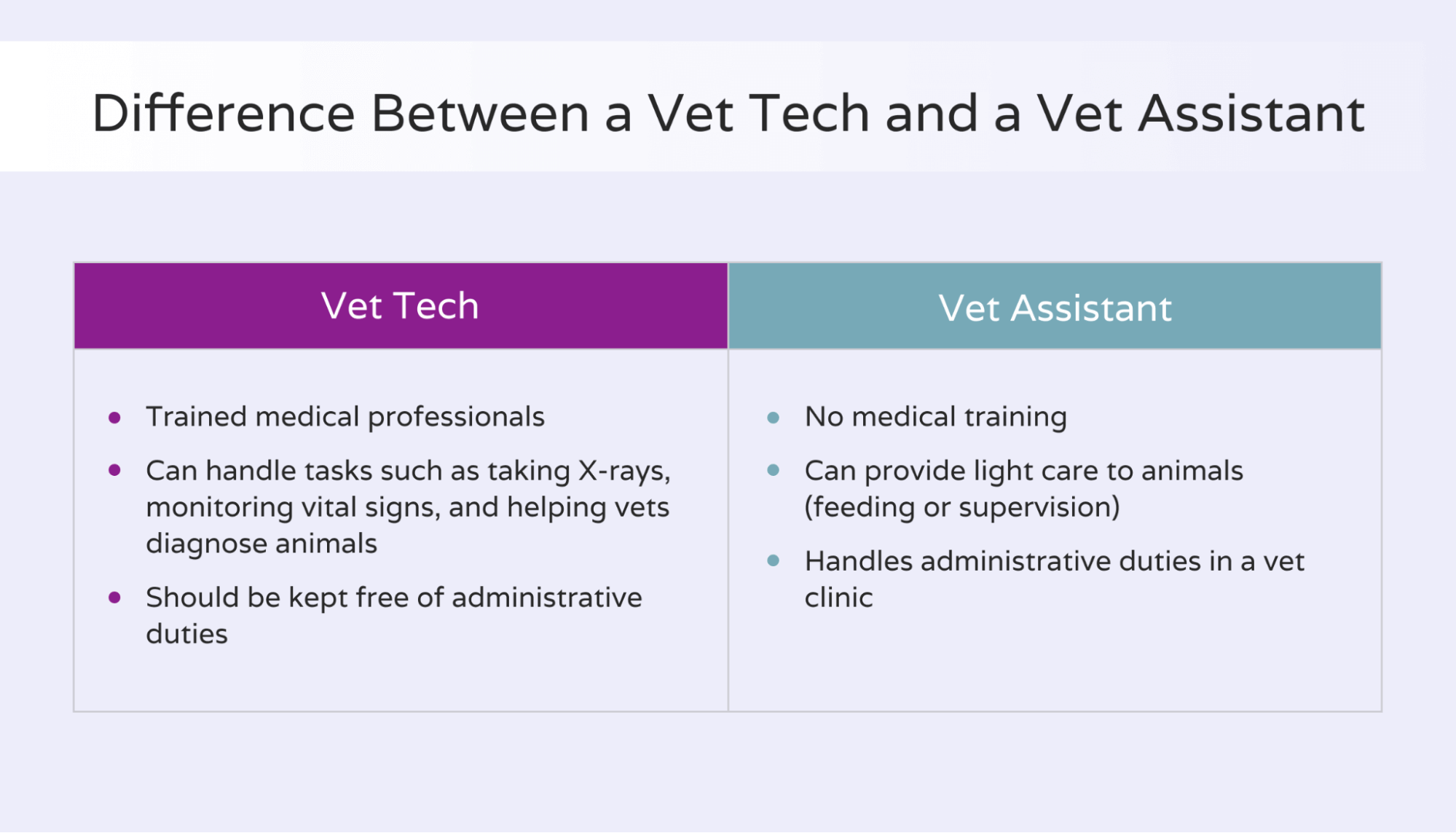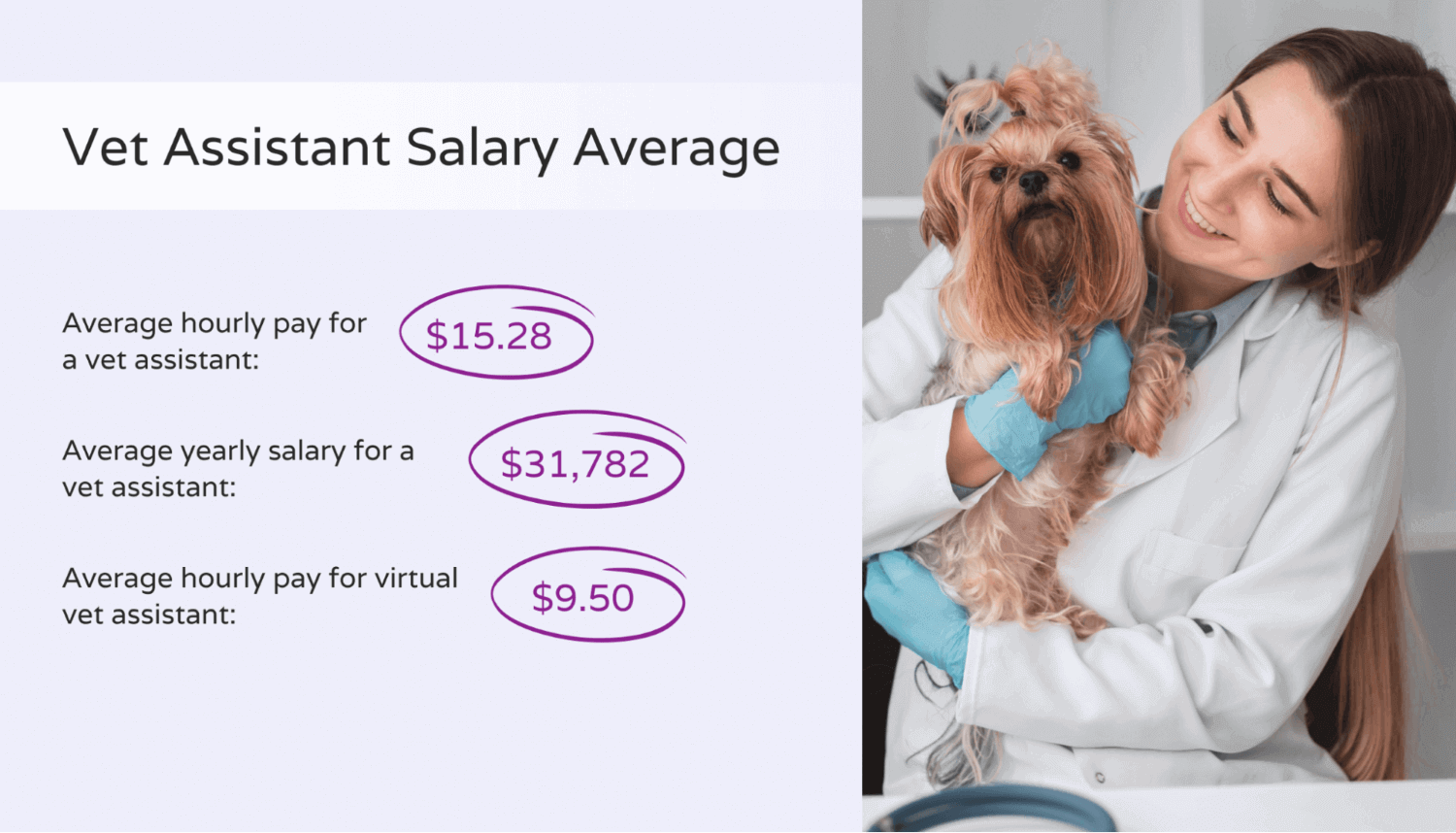Are you and your vet techs completely overwhelmed with mind-numbing, repetitive tasks and administrative processes? If so, you should consider hiring one or more veterinary assistants to relieve your medical staff from these tasks.
But how much does it really cost to hire a vet assistant? And should you hire a virtual vet assistant instead? Let’s explore the numbers behind a vet assistant’s salary and why virtual vet assistants are a much better investment for most vet clinics and veterinary hospitals.
What is a vet assistant?
A vet assistant is someone who works in a veterinary clinic to assist the staff and the patients. They’re also called paraveterinary workers.
Although some of their responsibilities may overlap with vet techs, they’re not the same type of workers. On the one hand, veterinary technicians provide services to the animals in your clinic. On the other hand, vet assistants support your techs and your vets with their daily tasks.

Veterinary assistants are especially talented at administrative tasks. Here are some examples of tasks you can delegate to a vet assistant in your clinic:
- Take notes during appointments and perform live charting
- Perform receptionist duties such as answering the phone, confirming appointments, greeting patients, processing payments, and more
- Update patient files and keep them organized
- Order supplies and handle the reception of merchandise
- Keep a regular inventory
- And so much more
Vet assistants don’t do technical tasks such as diagnosing animals, taking x-rays, monitoring vital signs, or other medical tasks involving animals. Although they can interact with animals, they’re not usually trained to do what vet techs can do.
Why do veterinarians need assistants?
If vet assistants can’t perform the same tasks a veterinary technician can, why do veterinarians need assistants in the first place?
The first reason is to keep vet techs focused on providing quality animal care. Vet techs are medical professionals who excel in that field. As such, they shouldn’t be weighed down by tasks that non-medical professionals can do.
Every minute a vet tech spends filling out paperwork or answering phone calls is a minute that could be spent providing higher quality care to the animals under their care instead.
The same goes for vets. Because vets are highly trained professionals, they can do tasks no one else in the clinic can do. Their time is highly valuable. So why should they focus their energy on tasks someone else could do, such as processing payments?
Having a vet assistant on your team can help reduce the administrative load of your clinic so you can devote more time and energy to your patients (and their nervous owners) and go home on time after the workday is done. Everyone does the job they’re the best at. As a result, everyone can focus on what they do best and excel in their field. Everyone wins, including your patients.
Plus, a vet assistant can stop important notes from falling through the cracks. For instance, you can have your vet assistant in your office perform live charting while you examine an animal. There’s no need to worry about remembering everything you say since you’ll have someone jotting everything down.
Plus, you can reduce expenses by hiring a vet assistant. If you have assistants take over the administrative duties you can hire fewer relatively more expensive techs.
Curious about how a virtual vet assistant could benefit your veterinary clinic? Book a call with our team, and we’ll help you find the perfect vet assistant for you.
Average vet assistant hourly pay
So how much do veterinary assistants make per hour? According to the Bureau of Labor Statistics, the mean hourly wage for this profession is $15.28 in the US. That equates to $31,782.40 per year.

However, this figure can vary per state. For instance, the average vet assistant salary in Texas is $31,444 per year, based on salary.com.
But hourly wages aren’t all you need to worry about if you hire an in-person vet assistant.
What benefits do you need to provide your vet assistant?
You need to account for more than just the salary of vet assistants. For instance, you need to provide:
- Social security
- Medicare and other health insurance
- Family and Medical Leave Act (FMLA) protections
- Unemployment insurance
- Worker’s compensation insurance
The specifics depend on your state and the size of your business. For instance, providing paid time off isn’t mandatory for small businesses, but it’s vital if you want to attract talent to your vet clinic.
Without adequate compensation, one of your competitors can easily poach your vet assistant by offering additional benefits or a higher hourly rate.
Should you hire a virtual vet assistant?
A vet assistant’s average base salary can be a bit steep for small vet clinics and animal hospitals – especially if you need more than one assistant due to an overflow of administrative tasks. At first, a national average salary of $15.28 an hour doesn’t seem too bad. But when you factor in the other benefits, this expense adds up quickly.
But did you know you can hire a virtual vet assistant to handle practically everything an in-person vet assistant can do? Although virtual veterinary assistants work from a remote location, they can still significantly reduce your workload at a fraction of the cost.
Here’s why you should consider hiring a virtual vet assistant instead of bringing an in-person employee to perform these tasks.
1. Cut down the costs of your vet assistant’s salary
Hiring an in-person vet assistant is expensive. Because their average hourly salary in the US is $15.28 without all the benefits, you can expect to shell out anywhere between $3,000 and $5,000 per month at minimum.
You’ll also pay in-person employees more for overtime. So whenever you have an overflow of administrative tasks, the cost of your in-person vet assistant will skyrocket.

On the other hand, virtual vet assistants with Hello Rache are only $9.50 per hour. That’s a flat fee that never changes, no matter how many hours you need from your virtual vet assistant.
With a virtual vet assistant, there’s no commitment necessary. You also don’t have to worry about benefits, social security, paid time off, or any other expenses. You can focus on getting your assistant to do the work you need for the hours you need while our team handles the rest.
Imagine you need a virtual vet assistant for 160 hours a month. Instead of paying $3,000 to $5,000 (and potentially more), you’ll pay a flat fee of $1,520. That’s half as much as you’d pay for an in-person vet assistant.
But you save even more when you consider the vet tech salary. Let’s say your vet tech gets paid at the US average rate of $18.39 per hour and performs an extra hour of overtime every day. At the overtime rate, that’s $27 per day or $540 per month. All that money gets saved when a virtual vet assistant takes over the overflow of work for you.
2. Provide a better service for your patients
A virtual vet assistant can help you improve your customer service at several levels.
First, your virtual vet assistant can perform a better follow-up for appointments since they won’t be distracted by other technical or medical tasks.
But you’ll also provide better care with a virtual vet assistant taking notes for you in your office. No more notes falling through the cracks as you try to remember what happened during an appointment.
Finally, you can have a faster reception area when you have additional veterinary assistants helping your in-house staff. As a result, your patients will be happier and more likely to return to your clinic.
3. Allow your medical staff to focus on their area of expertise
Your in-house vets and vet technicians can fully focus on what they do best – treat the beloved pets of your patients.
They’ll have fewer distractions, which means fewer mistakes.
Everyone does the job they’re best at and gets to fully focus on their responsibilities. For instance, there’s no need to ask a vet tech to perform medical data entry after an appointment if your virtual vet assistant gets it done instead.
4. Get home at 5 p.m.
If you’ve had to pick up the slack after work because of an overflow of administrative duties, a virtual vet assistant can take over those duties for you at a much lower cost than an in-person assistant.

As a result, you can run your vet clinic without overwhelming yourself or your in-house staff – and achieve a healthier work-life balance.
5. Attract better talent
There’s no need to compete locally for talented veterinary assistants when you can get the help of a remote vet assistant instead. Plus, there’s no need for additional job training.
You can onboard talented people without having to fight for them at the local level. Plus, you can outsource without the guilt since remote vet assistants have a lower cost of living.
Onboard a dedicated virtual vet assistant today
Are you overrun by admin work but struggle to justify hiring a vet assistant full-time at a competitive salary? Going virtual might be the answer to all of your needs.
You can easily optimize your veterinary clinic’s workflow by onboarding a dedicated virtual vet assistant. Book a call with us so we can help you find the best vet assistant for your veterinary clinic today.





